Alfa Romeo 166 2006 Owner handbook (in English)
Manufacturer: ALFA ROMEO, Model Year: 2006, Model line: 166, Model: Alfa Romeo 166 2006Pages: 272, PDF Size: 4.17 MB
Page 241 of 272
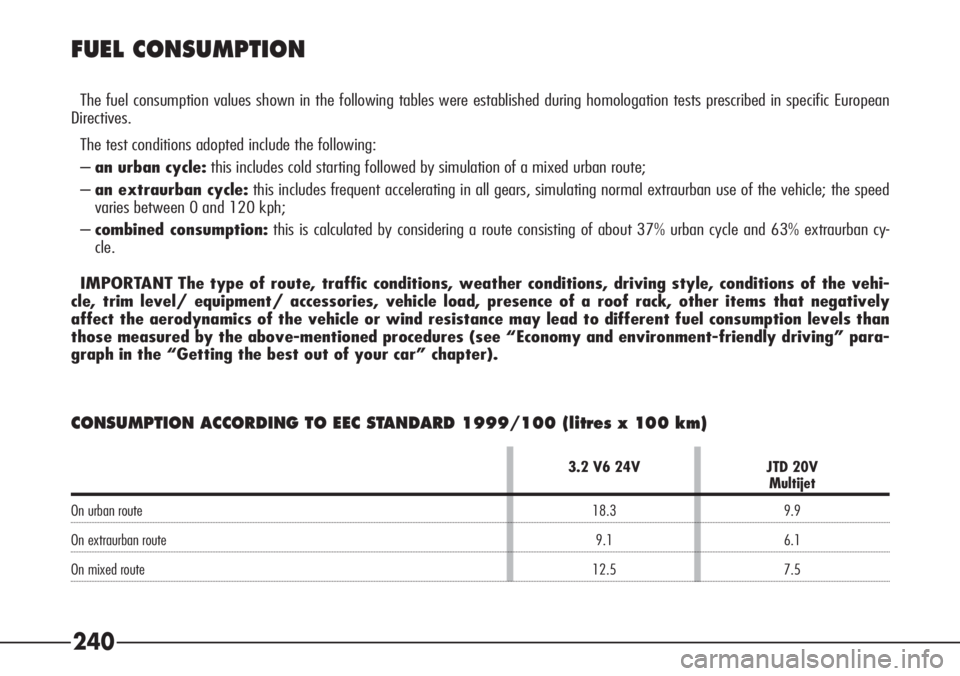
240
FUEL CONSUMPTION
The fuel consumption values shown in the following tables were established during homologation tests prescribed in specific European
Directives.
The test conditions adopted include the following:
–an urban cycle:this includes cold starting followed by simulation of a mixed urban route;
–an extraurban cycle:this includes frequent accelerating in all gears, simulating normal extraurban use of the vehicle; the speed
varies between 0 and 120 kph;
–combined consumption:this is calculated by considering a route consisting of about 37% urban cycle and 63% extraurban cy-
cle.
IMPORTANT The type of route, traffic conditions, weather conditions, driving style, conditions of the vehi-
cle, trim level/ equipment/ accessories, vehicle load, presence of a roof rack, other items that negatively
affect the aerodynamics of the vehicle or wind resistance may lead to different fuel consumption levels than
those measured by the above-mentioned procedures (see “Economy and environment-friendly driving” para-
graph in the “Getting the best out of your car” chapter).
CONSUMPTION ACCORDING TO EEC STANDARD 1999/100 (litres x 100 km)
3.2 V6 24V JTD 20VMultijet
On urban route 18.3 9.9
On extraurban route 9.1 6.1
On mixed route 12.5 7.5
Page 242 of 272
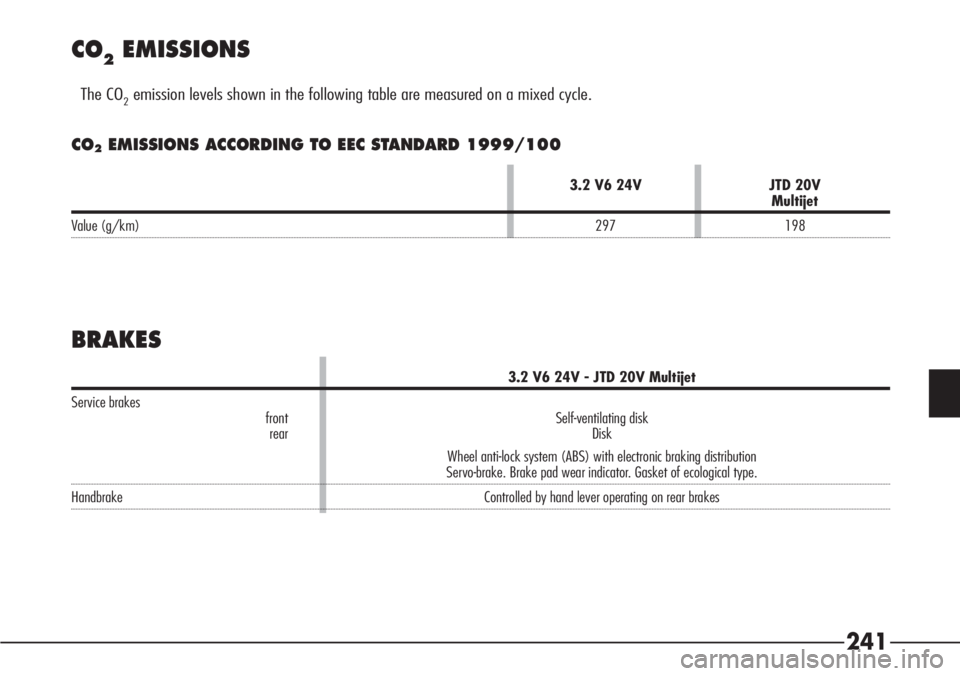
241
CO2EMISSIONS
CO2EMISSIONS ACCORDING TO EEC STANDARD 1999/100
BRAKES
The CO2emission levels shown in the following table are measured on a mixed cycle.
3.2 V6 24V JTD 20VMultijet
Value (g/km) 297 198
3.2 V6 24V - JTD 20V Multijet
Service brakes
front Self-ventilating disk
rear Disk
Wheel anti-lock system (ABS) with electronic braking distribution
Servo-brake. Brake pad wear indicator. Gasket of ecological type.
Handbrake Controlled by hand lever operating on rear brakes
Page 243 of 272
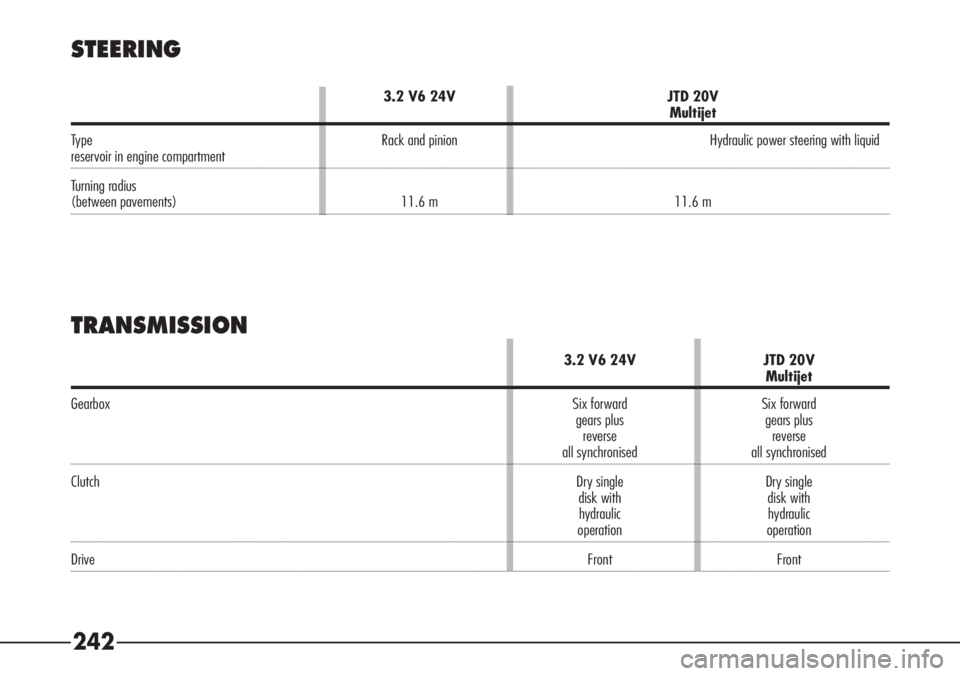
242
STEERING
3.2 V6 24V JTD 20VMultijet
Type Rack and pinion Hydraulic power steering with liquid
reservoir in engine compartment
Turning radius
(between pavements) 11.6 m 11.6 m
TRANSMISSION
3.2 V6 24V JTD 20VMultijet
Gearbox Six forward Six forward
gears plus gears plus
reverse reverse
all synchronised all synchronised
Clutch Dry single Dry single
disk with disk with
hydraulic hydraulic
operation operation
Drive Front Front
Page 244 of 272
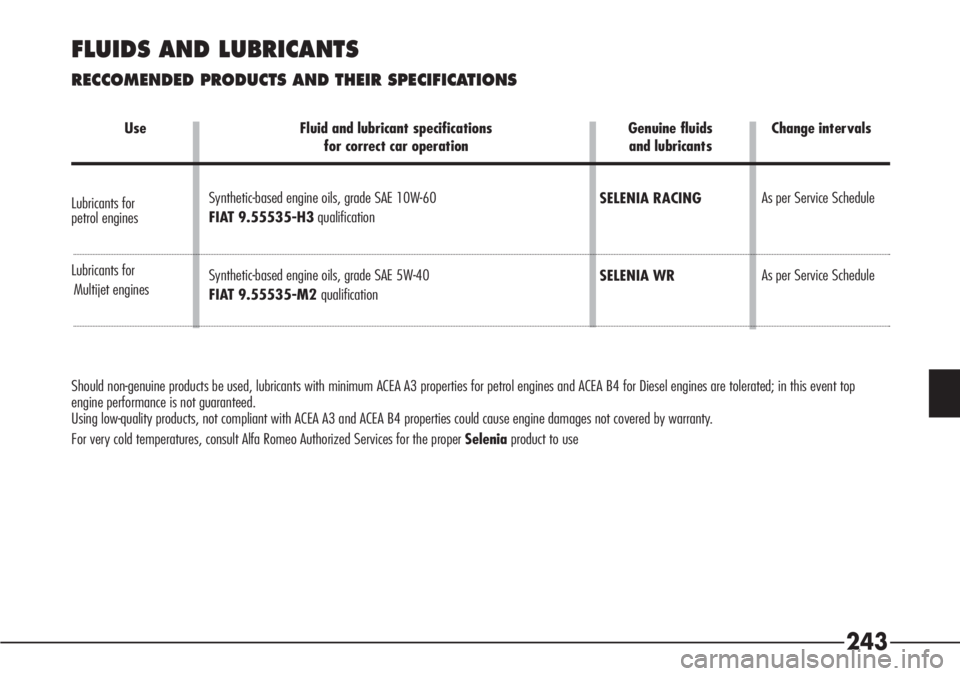
243
FLUIDS AND LUBRICANTS
RECCOMENDED PRODUCTS AND THEIR SPECIFICATIONS
Synthetic-based engine oils, grade SAE 10W-60
FIAT 9.55535-H3qualification
Synthetic-based engine oils, grade SAE 5W-40
FIAT 9.55535-M2 qualification
Should non-genuine products be used, lubricants with minimum ACEA A3 properties for petrol engines and ACEA B4 for Diesel engines are tolerated; in this event top
engine performance is not guaranteed.
Using low-quality products, not compliant with ACEA A3 and ACEA B4 properties could cause engine damages not covered by warranty.
For very cold temperatures, consult Alfa Romeo Authorized Services for the proper Seleniaproduct to useSELENIA RACING
SELENIA WRAs per Service Schedule
As per Service Schedule Use Fluid and lubricant specifications Genuine fluids Change intervals
for correct car operation and lubricants
Lubricants for
petrol engines
Lubricants for
Multijet engines
Page 245 of 272
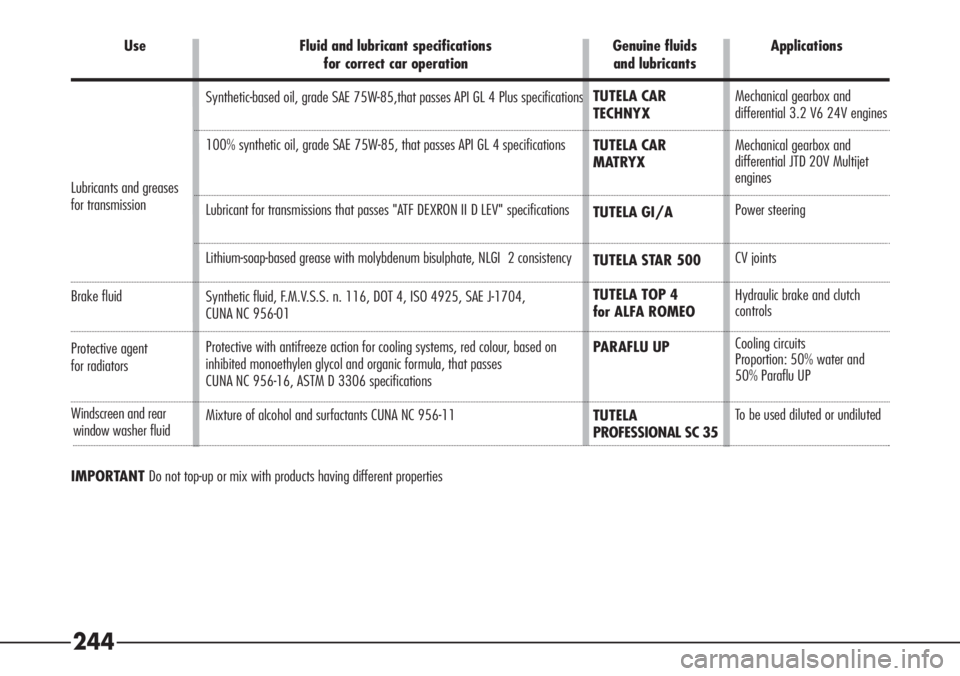
244
Mechanical gearbox and
differential 3.2 V6 24V engines
Mechanical gearbox and
differential JTD 20V Multijet
engines
Power steering
CV joints
Hydraulic brake and clutch
controls
Cooling circuits
Proportion: 50% water and
50% Paraflu UP
To be used diluted or undiluted TUTELA CAR
TECHNYX
TUTELA CAR
MATRYX
TUTELA GI/A
TUTELA STAR 500
TUTELA TOP 4
for ALFA ROMEO
PARAFLU UP
TUTELA
PROFESSIONAL SC 35 Synthetic-based oil, grade SAE 75W-85,that passes API GL 4 Plus specifications
100% synthetic oil, grade SAE 75W-85, that passes API GL 4 specifications
Lubricant for transmissions that passes "ATF DEXRON II D LEV" specifications
Lithium-soap-based grease with molybdenum bisulphate, NLGI 2 consistency
Synthetic fluid, F.M.V.S.S. n. 116, DOT 4, ISO 4925, SAE J-1704,
CUNA NC 956-01
Protective with antifreeze action for cooling systems, red colour, based on
inhibited monoethylen glycol and organic formula, that passes
CUNA NC 956-16, ASTM D 3306 specifications
Mixture of alcohol and surfactants CUNA NC 956-11
Use Fluid and lubricant specifications Genuine fluids Applications
for correct car operation and lubricants
Lubricants and greases
for transmission
Brake fluid
Protective agent
for radiators
Windscreen and rear
windowwasher fluid
IMPORTANT Do not top-up or mix with products having different properties
Page 246 of 272
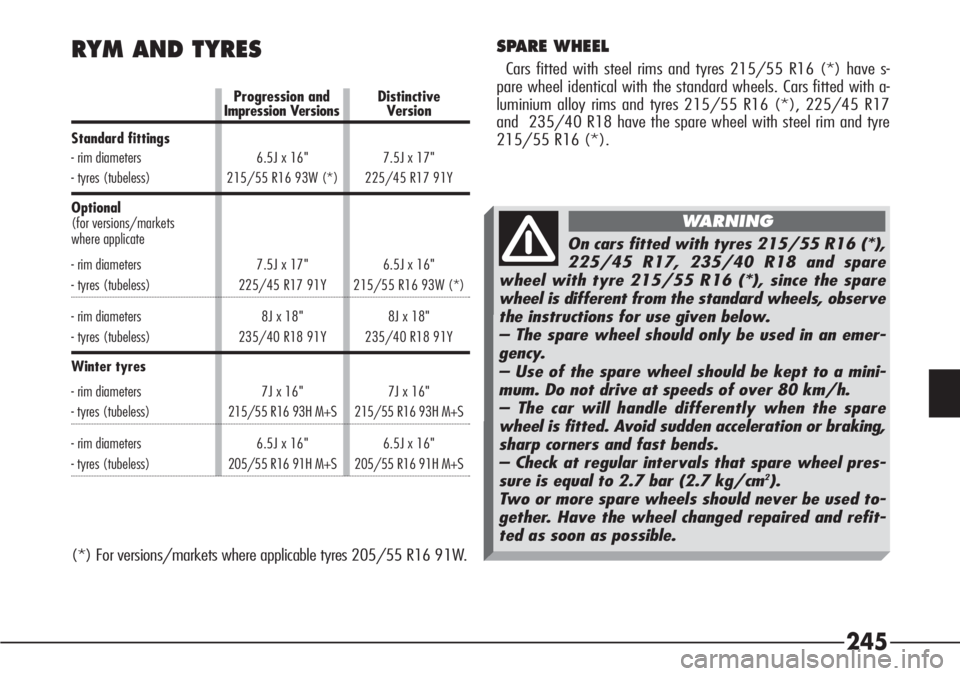
245
RYM AND TYRES
Progression and Distinctive Impression Versions Version
Standard fittings
- rim diameters 6.5J x 16" 7.5J x 17"
- tyres (tubeless) 215/55 R16 93W (*) 225/45 R17 91Y
Optional
(for versions/markets
where applicate
- rim diameters 7.5J x 17" 6.5J x 16"
- tyres (tubeless) 225/45 R17 91Y 215/55 R16 93W (*)
- rim diameters 8J x 18" 8J x 18"
- tyres (tubeless) 235/40 R18 91Y 235/40 R18 91Y
Winter tyres
- rim diameters 7J x 16" 7J x 16"
- tyres (tubeless)215/55 R16 93H M+S 215/55 R16 93H M+S
- rim diameters 6.5J x 16" 6.5J x 16"
- tyres (tubeless)205/55 R16 91H M+S 205/55 R16 91H M+S
(*) For versions/markets where applicable tyres 205/55 R16 91W.
SPARE WHEEL
Cars fitted with steel rims and tyres 215/55 R16 (*) have s-
pare wheel identical with the standard wheels. Cars fitted with a-
luminium alloy rims and tyres 215/55 R16 (*), 225/45 R17
and 235/40 R18 have the spare wheel with steel rim and tyre
215/55 R16 (*).
On cars fitted with tyres 215/55 R16 (*),
225/45 R17, 235/40 R18 and spare
wheel with tyre 215/55 R16 (*), since the spare
wheel is different from the standard wheels, observe
the instructions for use given below.
– The spare wheel should only be used in an emer-
gency.
– Use of the spare wheel should be kept to a mini-
mum. Do not drive at speeds of over 80 km/h.
– The car will handle differently when the spare
wheel is fitted. Avoid sudden acceleration or braking,
sharp corners and fast bends.
– Check at regular intervals that spare wheel pres-
sure is equal to 2.7 bar (2.7 kg/cm
2).
Two or more spare wheels should never be used to-
gether. Have the wheel changed repaired and refit-
ted as soon as possible.
WARNING
Page 247 of 272
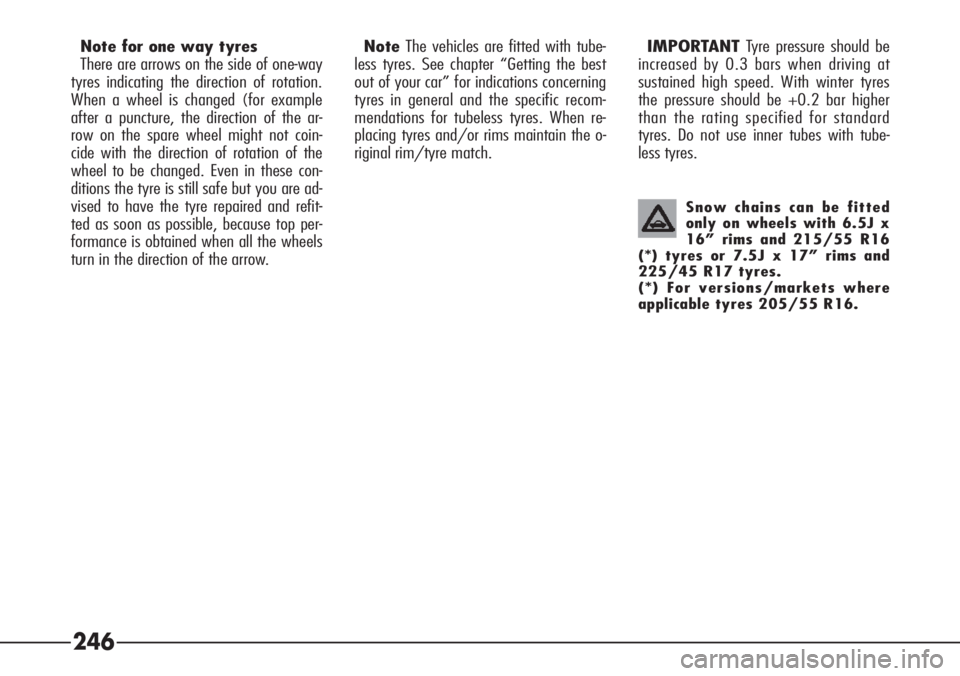
246
Note for one way tyres
There are arrows on the side of one-way
tyres indicating the direction of rotation.
When a wheel is changed (for example
after a puncture, the direction of the ar-
row on the spare wheel might not coin-
cide with the direction of rotation of the
wheel to be changed. Even in these con-
ditions the tyre is still safe but you are ad-
vised to have the tyre repaired and refit-
ted as soon as possible, because top per-
formance is obtained when all the wheels
turn in the direction of the arrow.NoteThe vehicles are fitted with tube-
less tyres. See chapter “Getting the best
out of your car” for indications concerning
tyres in general and the specific recom-
mendations for tubeless tyres. When re-
placing tyres and/or rims maintain the o-
riginal rim/tyre match.IMPORTANTTyre pressure should be
increased by 0.3 bars when driving at
sustained high speed. With winter tyres
the pressure should be +0.2 bar higher
than the rating specified for standard
tyres. Do not use inner tubes with tube-
less tyres.
Snow chains can be fitted
only on wheels with 6.5J x
16” rims and 215/55 R16
(*) tyres or 7.5J x 17” rims and
225/45 R17 tyres.
(*) For versions/markets where
applicable tyres 205/55 R16.
Page 248 of 272
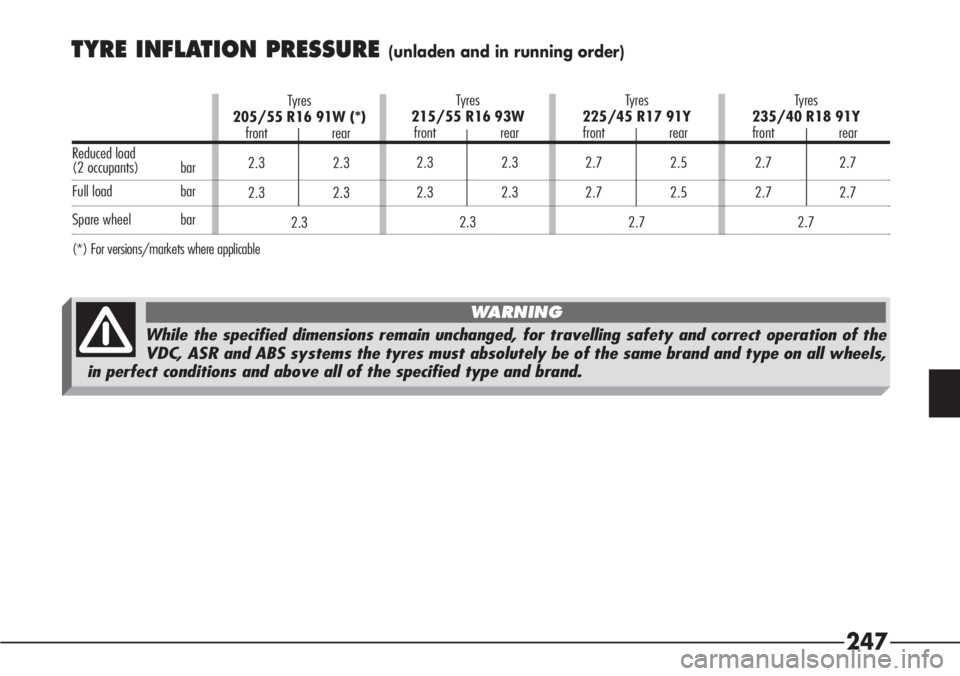
247
TYRE INFLATION PRESSURE (unladen and in running order)
Tyres
215/55 R16 93W
front rear
2.3 2.3
2.3 2.3
2.3 Tyres
205/55 R16 91W (*)
front rear
2.3 2.3
2.3 2.3
2.3Tyres
225/45 R17 91Y
front rear
2.7 2.5
2.7 2.5
2.7Tyres
235/40 R18 91Y
front rear
2.7 2.7
2.7 2.7
2.7
Reduced load(2 occupants) bar
Full load bar
Spare wheel bar
(*) For versions/markets where applicable
While the specified dimensions remain unchanged, for travelling safety and correct operation of the
VDC, ASR and ABS systems the tyres must absolutely be of the same brand and type on all wheels,
in perfect conditions and above all of the specified type and brand.
WARNING
Page 249 of 272
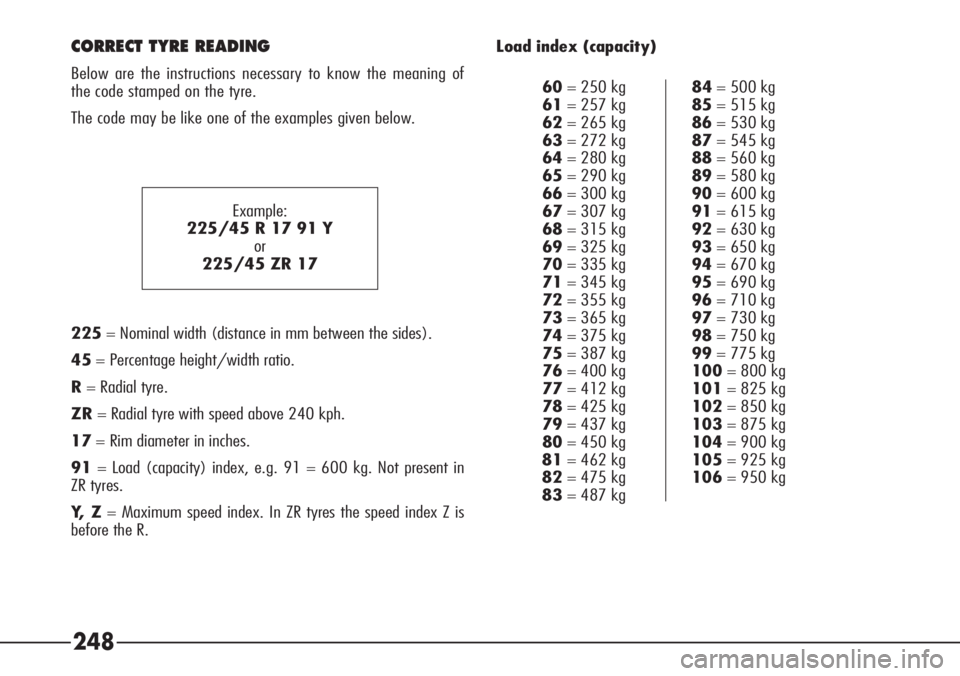
248
CORRECT TYRE READING
Below are the instructions necessary to know the meaning of
the code stamped on the tyre.
The code may be like one of the examples given below.
225= Nominal width (distance in mm between the sides).
45= Percentage height/width ratio.
R= Radial tyre.
ZR= Radial tyre with speed above 240 kph.
17= Rim diameter in inches.
91= Load (capacity) index, e.g. 91 = 600 kg. Not present in
ZR tyres.
Y, Z= Maximum speed index. In ZR tyres the speed index Z is
before the R.Load index (capacity)
60= 250 kg84= 500 kg
61= 257 kg85= 515 kg
62= 265 kg86= 530 kg
63= 272 kg87= 545 kg
64= 280 kg88= 560 kg
65= 290 kg89= 580 kg
66= 300 kg90= 600 kg
67= 307 kg91= 615 kg
68= 315 kg92= 630 kg
69= 325 kg93= 650 kg
70= 335 kg94= 670 kg
71= 345 kg95= 690 kg
72= 355 kg96= 710 kg
73= 365 kg97= 730 kg
74= 375 kg98= 750 kg
75= 387 kg99= 775 kg
76= 400 kg100= 800 kg
77= 412 kg101= 825 kg
78= 425 kg102= 850 kg
79= 437 kg103= 875 kg
80
= 450 kg104= 900 kg
81= 462 kg105= 925 kg
82= 475 kg106= 950 kg
83= 487 kg Example:
225/45 R 17 91 Y
or
225/45 ZR 17
Page 250 of 272
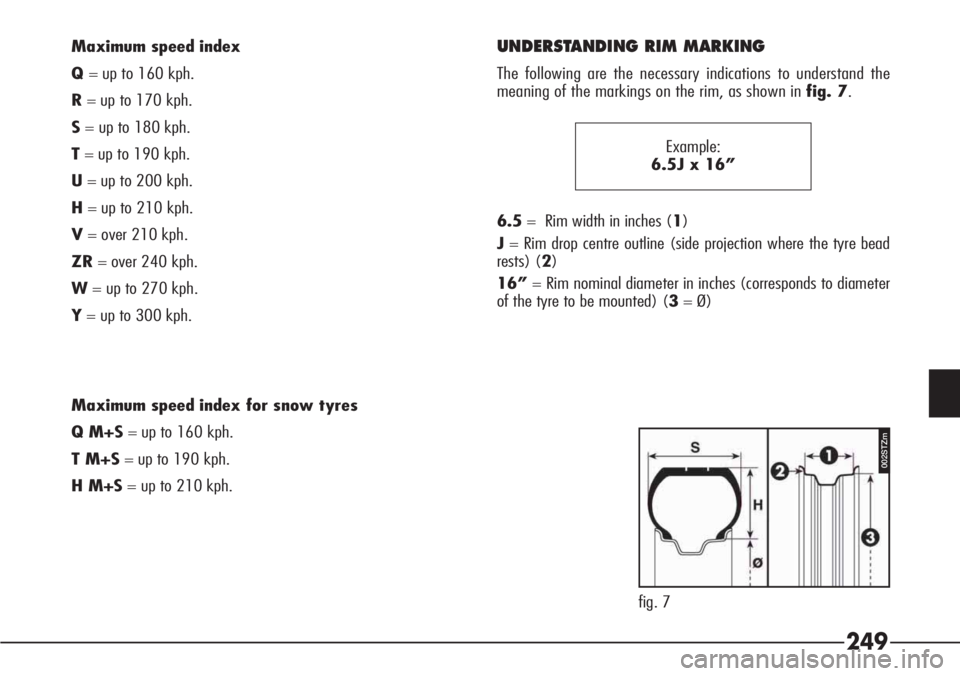
249
fig. 7 Maximum speed index
Q= up to 160 kph.
R= up to 170 kph.
S= up to 180 kph.
T= up to 190 kph.
U= up to 200 kph.
H= up to 210 kph.
V= over 210 kph.
ZR= over 240 kph.
W= up to 270 kph.
Y= up to 300 kph.
Maximum speed index for snow tyres
Q M+S= up to 160 kph.
T M+S= up to 190 kph.
H M+S= up to 210 kph.Example:
6.5J x 16”
UNDERSTANDING RIM MARKING
The following are the necessary indications to understand the
meaning of the markings on the rim, as shown in fig. 7.
6.5= Rim width in inches (1)
J= Rim drop centre outline (side projection where the tyre bead
rests) (2)
16”= Rim nominal diameter in inches (corresponds to diameter
of the tyre to be mounted) (3= Ø)
002STZm